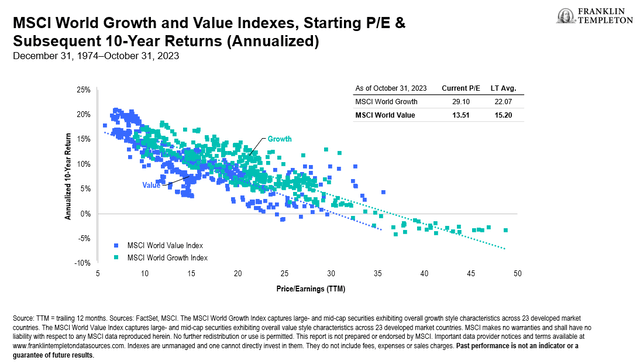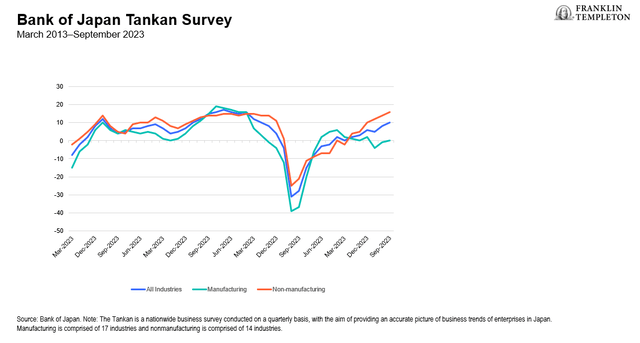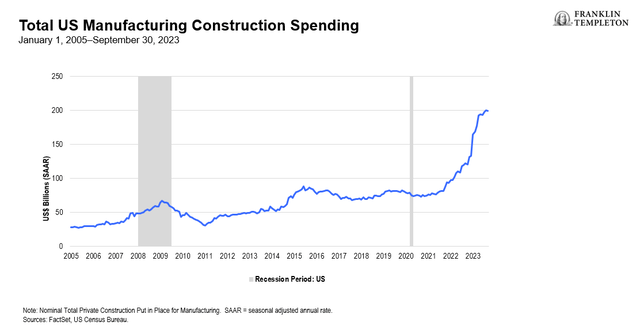tadamichi
By Christian Correa, CFA, Chief Investment Officer, Franklin Mutual Series
Value stocks are poised to deliver solid returns in what may demonstrate to be a more unsettled year ahead, according to Mutual Series CIO Christian Correa.
Value stocks are magnificently ordinary. Not only are they in less flashy sectors appreciate consumer staples, industrials and health care, but they also are trading at historically reasonable valuations.
That might be advantageous to investors in what could be an uncertain 2024 when investors could face higher volatility among expensive growth stocks, normalizing interest rates and the advance unwinding of pandemic-era stimulus.
Such an environment may make these ordinary value companies look extraordinary.
Value’s valuations matter
Although value stocks have lagged their growth counterparts over much of 2023, we believe the set-up for 2024 and beyond looks promising. Historically, starting valuations have been a strong indicator of long-term future returns.
Currently, the MSCI World Value Index’s price-earnings (P/E) multiple is trading at a discount to its historical average, whereas the P/E multiple for the MSCI World Growth Index is at a premium.
As seen in Exhibit 1, comparing the trailing P/E multiples for global growth and value stocks with their return over the next 10 years shows that lower P/E stocks achieved higher future returns over the next decade, based on data from FactSet and MSCI.
As such, with growth stocks’ stretched valuations, we see many opportunities to find compelling value opportunities with significant future return potential.
Exhibit 1: Valuations Matter for Long-Term Returns
Furthermore, we believe that finding companies with compelling catalysts that can unlock value and create solid long-term returns will remain crucial for separating appealing value stocks from potential value traps, particularly in an environment of increasing uncertainty.
We also think the market should reward stable cash flow generation and financial returns. We believe it’s important to focus on cash flows and financial returns to comprehend how a company is run and whether it can produce strong share price appreciation for investors over time.
Diversification over concentration
With 2023 global market returns concentrated in a handful of US stocks, seeking out value stocks can give investors more diversified global exposure and potentially more consistent returns over time, in our view.
We tend to think the world outside the United States has more opportunities. While we do see some US prospects, when we look at Europe, for example, we can find big globally competitive companies that are trading at compelling valuations and supply the potential opportunity for attractive future returns.
Japan is also an increasingly dynamic market worth investors’ attention, in our view. More and more Japanese companies are focused on improving returns on capital, raising prices amid higher inflation and are willing to take more risks to follow faster growth – a marked change from the past few decades.
The Tokyo Stock Exchange is also pushing reforms to get companies to raise their book values.
Despite a strong performance this year, Japanese stock valuations (based on FactSet data) remain attractive to us, as the country exits a long period of negative interest rates and overall business sentiment continues to better (Exhibit 2).
Exhibit 2: Bank of Japan Tankan Judgment Survey Shows Growing Corporate Optimism
Monetary policy normalization in many countries should advance positively impact certain value-oriented sectors. Higher interest rates have lured capital away from dividend-paying industries toward fixed income over the past year.
For value investors, the drop in valuations in the consumer staples, utilities and real estate sectors, for instance, can create greater prospects of finding stocks unfairly trading below their fundamental value.
Government infrastructure spending and the long-term energy transition is also geared toward sectors that trade at “value” multiples, such as companies in the energy, industrials and materials sectors.
US government spending on building new semiconductor and electric vehicle battery plants, for one, should direct to greater spending on the metals, cement and industrial equipment used to build them.
US spending on manufacturing facilities has risen sharply since recent legislation was passed in Congress. (See Exhibit 3.)
Exhibit 3: US Stimulus Infrastructure Spending Booms
Momentum behind the energy transition also continues to push energy companies and utilities toward embracing cleaner energy.
While we do not think oil is going away, global utilities are closing coal plants and rolling out renewable projects, incentivized by a slew of recent legislation in the United States and in Europe.
Pandemic’s end
Consumer spending is an area of concern. While growth has slowed as Americans spend the last of their pandemic-era savings, student loan repayments are restarting and low-end consumers are dealing with higher energy costs. We believe what is happening is only a spending slowdown, not a shutdown.
The labor market has so far remained resilient with increased participation, rising wages and persistently low unemployment supported by continued business and government infrastructure spending.
However, should wages, employment or the promised infrastructure spending falter, we would not be surprised to see an economic slowdown.
Regardless, after a year when value underperformed growth stocks globally, we foresee a brighter year ahead as global stock valuations propose to us positive long-term return potential.
More money should also flow to value-oriented parts of the market and economy through ongoing consumer spending and recent government programs, while normalized monetary policy can make interest rate-sensitive and dividend-paying groups more appealing. Extraordinary value. Extraordinary potential.
What are the risks?
All investments involve risks, including possible loss of principal.
Equity securities are subject to price fluctuation and possible loss of principal.
To the extent a strategy invests in companies in a specific country or region, it may experience greater volatility than a strategy that is more broadly diversified geographically.
International investments are subject to special risks, including currency fluctuations and social, economic and political uncertainties, which could enhance volatility. These risks are magnified in emerging markets.
Value securities may not enhance in price as anticipated or may refuse advance in value. The investment style may become out of favor, which may have a negative impact on performance.
Active management does not ensure gains or protect against market declines.
Editor’s Note: The summary bullets for this article were chosen by Seeking Alpha editors.






